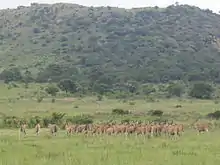| Suikerbosrand Nature Reserve | |
|---|---|
 Suikerbosrand Nature Reserve gorge | |
| Location | South Africa |
| Nearest city | Heidelberg, Gauteng |
| Coordinates | 26°30′S 28°15′E / 26.500°S 28.250°E / -26.500; 28.250 |
| Area | 11,595 ha (28,650 acres) |
| Established | 27 March 1974 |
| Operated by | Gauteng Department of Agriculture, Conservation, Environment and Land Affairs |
| Website | Gauteng Tourism Authority |
Suikerbosrand Nature Reserve is a protected area which encompasses most of the Suikerbosrand Range, South Africa.[1] It is one of Gauteng’s most frequented ecotourism destinations. Set just a short distance from Johannesburg, an hour's drive from Johannesburg International Airport and adjacent to the historical town of Heidelberg, it offers a refreshing break from the bustling city life.
The reserve boasts a representative sample of the fauna and flora of the rocky highveld grassland biome. With 134 km2 (52 sq mi) of unspoiled natural environment and a mountain range characterised by meandering twists and turns of hiking trails, besides a tarred circular route for motorists. It lies in the upper catchment of the Klip and Suikerbosrand Rivers, and the altitude varies between 1,545 and 1,917 m (5,069 and 6,289 ft) above sea level.
History
The Suikerbosrand ridge was originally named after a sweet reed (probably sweet sorghum) found growing here by the party of general Hendrik Potgieter on 5 June 1836.[2] Later the ridge and consequently the reserve's name became associated with the characteristic Transvaal-sugar bush (Protea caffra), a dominant vegetation type within the area's limits.[3]
Recent land acquisitions at the beginning of the twenty-first century[4] have seen the reserve almost double in its size. A huge challenge for the reserve's management is to include the newly acquired lands in the reserve without disturbing the balance within the original area. The Suikerbosrand Nature Reserve is managed by the Gauteng province's Department of Agriculture, Conservation, Environment and Land Affairs, South Africa.
Wildlife
Over 200 bird species have been identified in the reserve. The reserve is also a habitat for a large range of mammal species including:[5]
Cycling and mountain biking


The reserve is popular amongst mountain bikers and road cyclists for its quiet roads and trails, scenery, steep climbs, and fast twisting descents.
Hiking
The reserve includes a Visitors' Centre and the Diepkloof Farm Museum. The reserve can be explored on foot using several of the day and overnight hiking trails.
Holiday resort
A holiday resort[6] for day visitors (apparently day visitors are no longer allowed in at Kareekloof) and overnight campers is situated within the nature reserve. (It was previously known as Kareekloof)
Accommodation is in the form of chalets, caravan (some with 240 V power) and tent sites.
See also
Notes
- ↑ "Gazetted Name: Suikerbosrand Nature Reserve" (PDF).
- ↑ du Plessis, E.J. (1973). Suid-Afrikaanse berg- en riviername. Tafelberg-uitgewers, Cape Town. p. 181. ISBN 0-624-00273-X.
- ↑ Raper, P.E. (2004). South African Place Names. Jonathan Ball, Jhb & Cape Town. p. 358. ISBN 1-86842-190-2.
- ↑ "Suikerbosrand Nature Reserve - conservation action". BirdLife South Africa. Retrieved 12 October 2017.
- ↑ Coral Birss & Neville Green (September 2007). "Suikerbosrand Nature Reserve and Extension Ecological management Plan" (PDF). Gauteng Department of Agriculture, Conservation, Environment and Land Affairs. p. 56. Retrieved 25 November 2008.
- ↑ "Protea Hotels & Inns - Protea Hotel Suikerbosrand". Archived from the original on 26 June 2007.
External links
![]() Media related to Suikerbosrand Nature Reserve at Wikimedia Commons
Media related to Suikerbosrand Nature Reserve at Wikimedia Commons
Parks managed by the Gauteng Department of Agriculture and Rural Development | |
|---|---|
Authority control databases | |
|---|---|
| International | |
| National | |